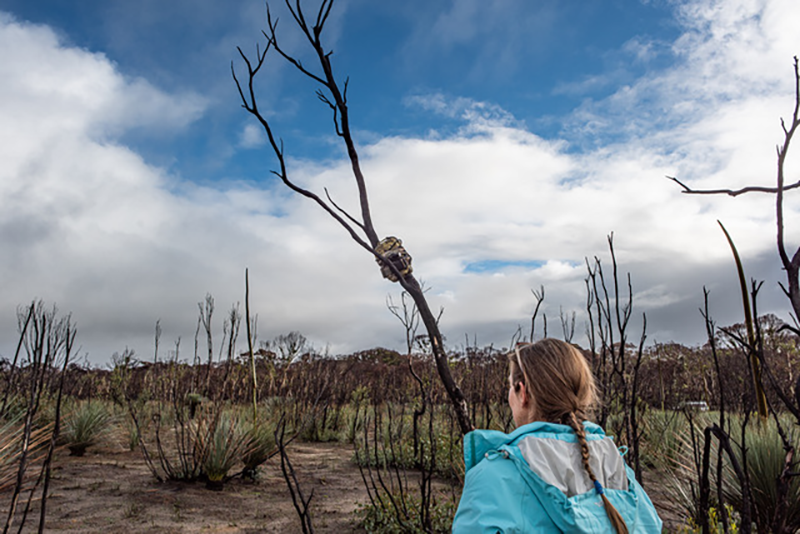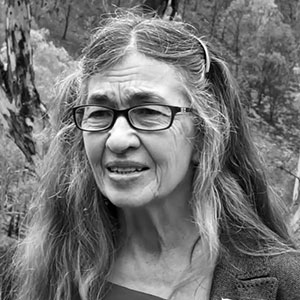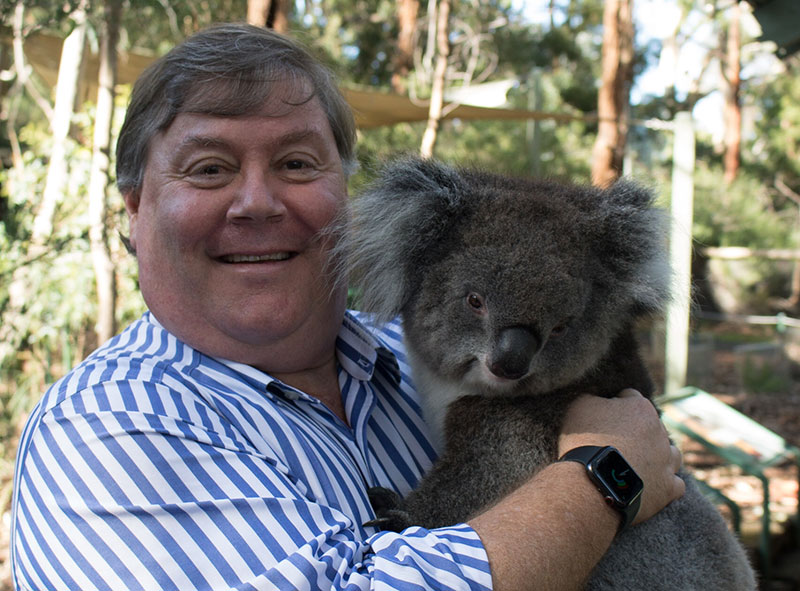A lone firefighter confronting a wall of flames and smoke in the Adelaide Hills, with a koala at his feet, both stunned by the ferocity of the scene before them.
The photo captured hearts the world over, contributing to an international outpouring of donations but also a harsh global backlash. How could we put our iconic wildlife – the very thing that symbolises Australia – at so much risk?
Blame has been sheeted home to many quarters for the devastating bushfires over the summer that torched more than 17 million hectares nationwide, killing or displacing three billion animals, killing 33 people, and rendering precious flora extinct.
Rising temperatures, a prolonged drought, cutbacks to prescribed burning, poor vegetation management, unchecked development, careless law enforcement and pure complacency all contributed to a perfect storm – or a terrifying wildfire in this case.
Climate change has been at the heart of discussions but the long road back to recovery for Australia’s flora and fauna requires far more than taking action to mitigate a warming world.
UniSA wildlife ecologist Associate Professor Topa Petit was working on Kangaroo Island in January when apocalyptic fires ravaged more than 215,000 hectares, leaving the western half a blackened, desolate landscape.
The overwhelming feeling was powerlessness as Assoc Prof Petit and others could do nothing but stand by and watch firefighters battle the blaze, but the UniSA researcher is now playing a role in Kangaroo Island’s recovery.
Thanks to a special UniSA Vice Chancellor fund, Assoc Prof Petit is coordinating a nest box project for insectivorous bats, pygmy possums and some birds.
 Assoc Prof Topa Petit on Kangaroo Island.
Assoc Prof Topa Petit on Kangaroo Island.
The nest boxes are numbered, measured, deployed and monitored with the help of an army of community volunteers.
Assoc Prof Petit is also developing an artificial nectar supplementation project to attract honeyeaters and pygmy possums, but also insects, which are at the base of the food chain for a large range of animals.
Assoc Prof Petit says the bushfires left a severe impact on Kangaroo Island, increasing the threat to many species, including the already endangered glossy black cockatoos, Kangaroo Island dunnarts, echidnas and southern brown bandicoots.
“Birdlife Australia also identified 19 species of birds that lost at least 50 per cent of their habitat and 16 of those were on Kangaroo Island, including the western whipbird, Bassian thrush and the southern emu-wren.”
The wildlife ecologist rejects calls for an increase in fuel-reduction burns, claiming they do little to reduce the risk to vegetation and wildlife.
“Fire is okay for some vegetation communities but many iconic animal species thrive in long-unburned habitats,” she says. “Recently burned habitats will burn again and by increasing the frequency of fires, we reduce humidity and biodiversity.”
Assoc Prof Petit acknowledges the use of cool burning in some Aboriginal communities but says these landscapes are designed for cultural practices such as hunting, rather than to restore nature.
Facilitating wildlife recovery is difficult. For example, bringing food into denuded native habitats is fraught with danger she says, because it increases habitat damage and risk of disease in wildlife, and makes them dependent on people for food, which is unsustainable in the long term.
“The effect may be compounded if you rescue animals, look after them, and then return them to patches of over-exploited habitat. It’s a soul-destroying problem, because what can you do then to avoid the destruction of habitat that’s left?”
Animals depend on vegetation for shelter, cover and food. Efforts to tackle weeds and to encourage natural revegetation or restoration using locally sourced seeds are also worth considering.
“The most important lesson to come out of this tragedy is that protected areas need to remain protected,” she says. “They should not be opened to private developers under any circumstances.
“Flinders Chase National Park was the primary hotspot of biodiversity in South Australia, but I fear it will take 100 years for it to return to the condition in which it was, if it ever does.”
Nature has not taken long to remind us of her resilience, however.

Nine months after fires destroyed 70 acres of her Cudlee Creek property, UniSA Adjunct Research Fellow Joan Gibbs says the recovery is plain to see.
The first signs of green shoots were evident within a fortnight, with the exotic plantain and Salvation Jane, and the native eucalypts, bracken fern and native Oxalis resprouting vigorously, adding some colour to a charred landscape.
Landcare Australia and NRM (Natural Resources Management) have also come to the rescue with community grants to help recover lost habitats, biodiversity and grazing/farming landscapes.
“With the Landcare grant we will buy nest boxes, tree guards and technological aids to restore native shrubs and grasses and with every passing week we are seeing rapid changes, aided by rain and falling temperatures,” Gibbs says.
The exotics are fighting for dominance, with blackberries and broom rising from the ashes and taking advantage of the empty space.
“This is going to be our biggest challenge – keeping the exotics in check, while still recognising they perform an important function in the ecosystem.”
Exotics hold the soil together on the sleep slopes and creek lines to give cover and biomass for lizards and insects, as well as kickstarting the recycling of leaf litter and nutrients. The right balance of exotics and natives will be key to the recovery of the landscape, Gibbs says.
“The actions we take now to restore the ecosystem will determine our future environment. Our eucalyptus trees have survived bushfire cycles for the past 80,000 years, but the ground layers that return immediately will determine not only future fire behaviour but also habitats for wildlife and people.”

UniSA environmental scientist Associate Prof Delene Weber believes the summer fires were a tipping point for Australia, a reminder that climate change is an urgent issue which can no longer be ignored.
“Fire is part of our natural ecosystem but the intensity, behaviour, breadth and frequency of these fires is something we have never experienced before,” Assoc Prof Weber says.
From a land management perspective, a mundane but crucial first step would be to remove some of the more invasive weeds from our environment.
Tenure-blind burning – prioritising areas to burn based on risk assessment, regardless of whether it is public or private land – should also be a priority, she says.
“We have the technology at UniSA – using drones with a hyperspectral payload – to assess fuel loads across the landscape to make scientific decisions about where burning needs to take place,” Assoc Prof Weber says.
“It is important to work collaboratively with the CFS, Department for Environment and Water, primary producers and scientists – instead of in silos – to achieve the best results.”
Individuals and communities need to be better educated about fires, perhaps making it part of the school curriculum. Most importantly, the dependency on volunteer firefighters to 'save the day' is pure folly, she says.
“Australians have this superhero mentality when it comes to our firefighters, which is extremely dangerous. We don’t live in the Marvel universe and we shouldn’t assume that the CFS is going to turn up at the 11th hour and save our house.
“It is incumbent on everyone to do their bit to protect their property, take responsibility for learning about fire and reduce the risks as much as possible.”
THE KOALA CONUNDRUM
 Professor Chris Daniels with a koala. Photo courtesy Cleland Wildlife Park.
Professor Chris Daniels with a koala. Photo courtesy Cleland Wildlife Park.
They are a symbol of Australia and one of the most charismatic and loved animals in the world but the cuddly koala is creating something of a conundrum for environmentalists.
Geography is determining their status. Koala populations in NSW, Queensland and the ACT have declined by two thirds in the past 20 years and last summer’s bushfires have pushed them to the brink of extinction in those states. In South Australia it’s a different story. Yes, the fires decimated koala populations on Kangaroo Island and a section of the Adelaide Hills, but in recent years their swelling numbers have put enormous pressure on local habitats.
UniSA Adjunct Professor of Biology Professor Chris Daniels, who is CEO of the newly-established International Koala Centre of Excellence, situated in Cleland Wildlife Park, says that before the fires, Kangaroo Island supported about 50,000 koalas while up to 150,000 inhabited the Mt Lofty Ranges.
“The stress on gum trees and other fauna from high koala populations has been considerable in South Australia,” Prof Daniels says. “When the numbers get too high, they end up killing all the trees and then starving to death. That creates an international outcry but it’s difficult to manage because culling is not widely supported, and sterilisation is too expensive at around $350 an animal.”
Koalas eat a lot – the equivalent of about 50 trees a year. Multiply that by 50,000 on Kangaroo Island and that puts a lot of stress on the local environment.
Fires have wiped out 80 per cent of their island habitat but they will recover, not least because they are prodigious breeders.
Earlier this year, 28 rescued disease-free koalas from Kangaroo Island were thrown a lifeline by Cleland Wildlife Park (CWP), which has established a sanctuary on its grounds to protect this unique group.
The so-called “Golden Children” (named after the 1986 Eddie Murphy film) are the only chlamydia-free and koala retro virus-free colony in the world. With perhaps as few as 5000 koalas remaining on the island, the risk of chlamydia crossing from the mainland via sheep and cattle is high, Prof Daniels says, making their protection a priority.
CWP has quarantined the 28 koalas, separating them from the eight recovering koalas rescued from the Cudlee Creek fire.
The International Koala Centre of Excellence is now seeking funding to build a facility which will house researchers from around the world – including UniSA – on every aspect of koalas, including their genetic makeup, disease susceptibility, impact on the environment, habitat, diet and behaviour.
“We expect UniSA will focus on how koalas connect people with nature and what the special relationship is between humans and these iconic animals,” Prof Daniels says.
“Koalas underpin so much of our society and identity in many ways. They are unique to Australia, they are important for tourism and they are also the poster children for climate change in our country. Their conservation is paramount.”
More information about the development of the centre is available at www.koalacentre.org